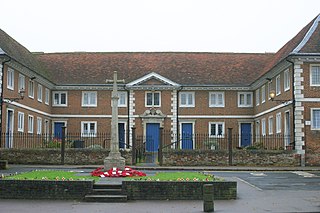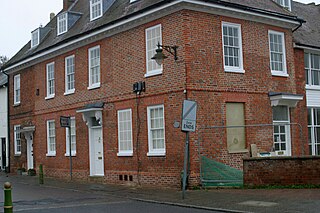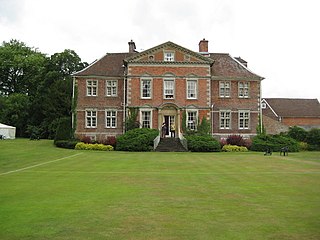
Hadleigh is an ancient market town and civil parish in South Suffolk, East Anglia, situated, next to the River Brett, between the larger towns of Sudbury and Ipswich. It had a population of 8,253 at the 2011 census. The headquarters of Babergh District Council were located in the town until 2017.

Buntingford is a market town and civil parish in the district of East Hertfordshire and county of Hertfordshire in England. It lies next to the River Rib and is located on the historic Roman road, Ermine Street. As a result of its location, it grew mainly as a staging post with many coaching inns and has an 18th-century one-cell prison known as The Cage, by the ford at the end of Church Street. It has a population of 7879, as of the 2021 UK Census.

Sunbury-on-Thames is a suburban town on the north bank of the River Thames in the Borough of Spelthorne, Surrey, centred 13 mi (21 km) southwest of central London. Historically part of the county of Middlesex, in 1965 Sunbury and other surrounding towns were initially intended to form part of the newly created county of Greater London but were instead transferred to Surrey. Sunbury adjoins Feltham to the north, Hampton to the east, Ashford to the northwest and Shepperton to the southwest. Walton-on-Thames is to the south, on the opposite bank of the Thames.

Shepperton is an urban village in north Surrey, England, around 15 mi (24 km) south west of central London. On the north bank of the River Thames, the settlement is in the Borough of Spelthorne, approximately equidistant between the towns of Chertsey and Sunbury-on-Thames. The village is mentioned in a document of 959 AD and in the Domesday Book.

Chertsey is a town in the Borough of Runnymede, Surrey, England, 29 km (18 mi) south-west of central London. It grew up round Chertsey Abbey, founded in 666 CE by St Erkenwald, and gained a market charter from Henry I. A bridge across the River Thames first appeared in the early 15th century. The River Bourne through the town meets the Thames at Weybridge. The Anglican church has a medieval tower and chancel roof. The 18th-century listed buildings include the current stone Chertsey Bridge and Botleys Mansion. A curfew bell, rung at 8 pm on weekdays from Michaelmas to Lady Day ties with the romantic local legend of Blanche Heriot, marked by a statue of her and the bell at Chertsey Bridge. Green areas include the Thames Path National Trail, Chertsey Meads and a round knoll with remains of a prehistoric hill fort known as Eldebury Hill. Pyrcroft House dates from the 18th century and Tara from the late 20th. Train services are run between Chertsey railway station and London Waterloo by South Western Railway. The town is within the M25, accessible via junction 11.

Shackleford is a village and civil parish in the Borough of Guildford, Surrey, England centred to the west of the A3 between Guildford and Petersfield 32 miles (51 km) southwest of London and 5.2 miles (8.4 km) southwest of Guildford. Shackleford includes the localities of Eashing, Hurtmore, Norney and Gatwick.

Buntingford Almshouses is a grade II* listed building on the High street of the Hertfordshire town of Buntingford. The building was erected in 1684 by the mathematician and astronomer Bishop Seth Ward who was born in the town. The architect was probably the celebrated scientist and architect, Robert Hooke.

The Red House is a Queen Anne style house built around 1710 opposite the intersection of Norfolk Road and High Street in Buntingford, Hertfordshire, England. It was inhabited by artist and stage designer Claud Lovat Fraser, who designed the Buntingford war memorial and other aspects of the town. The building was used by estate agency Churchills, but currently appears unoccupied. It is a Grade II Listed Building.

Ardeley is a small village and civil parish in East Hertfordshire, England. The parish includes the hamlet of Cromer, as well as Wood End and Moor Green.

Langleybury is a country house and estate in Abbots Langley, Hertfordshire, England, about 3 miles (5 km) northwest of the centre of the town of Watford. The house stands on a low hill above the valley of the River Gade.
The Headstone Museum, also known as the Harrow Museum, is the local history museum for the London Borough of Harrow in England.

The Grade I listed buildings in Somerset, England, demonstrate the history and diversity of its architecture. The ceremonial county of Somerset consists of a non-metropolitan county, administered by Somerset County Council, which is divided into five districts, and two unitary authorities. The districts of Somerset are West Somerset, South Somerset, Taunton Deane, Mendip and Sedgemoor. The two administratively independent unitary authorities, which were established on 1 April 1996 following the breakup of the county of Avon, are North Somerset and Bath and North East Somerset. These unitary authorities include areas that were once part of Somerset before the creation of Avon in 1974.

As of 2011 there were 102 listed buildings and structures in the English borough of Crawley, West Sussex. Two others have subsequently gained listed status. The Borough of Crawley is based on the town of the same name, located approximately halfway between London and Brighton. Although Crawley expanded substantially after World War II when it was designated a New Town by an Act of Parliament, many older buildings remain.

Ashtead Park is a 24.2-hectare (60-acre) Local Nature Reserve in Ashtead in Surrey. It is owned by Mole Valley District Council. It contains several important listed buildings. The Park itself has remains of a Roman building, four lakes/ponds and the school's playing fields and is Grade II listed on the Register of Historic Parks and Gardens.

The Normansfield Theatre is a Victorian era building in Teddington, England.

The White Lion is a Grade II listed public house in Putney, in the London Borough of Wandsworth.

St Edmund's Church is the Roman Catholic parish church of Godalming, a town in the English county of Surrey. It was built in 1906 to the design of Frederick Walters and is a Grade II listed building. The church stands on a "dramatic hillside site" on the corner of Croft Road just off Flambard Way close to the centre of the town.




















